
Marquess of Anglesey is a title in the Peerage of the United Kingdom. It was created in 1815 for Henry Paget, 2nd Earl of Uxbridge, a hero of the Battle of Waterloo, second in command to the Duke of Wellington. The Marquess holds the subsidiary titles of Earl of Uxbridge, in the County of Middlesex, in the Peerage of Great Britain (1784), Baron Paget, de Beaudesert, in the Peerage of England (1553), and is also an Irish Baronet, of Plas Newydd in the County of Anglesey and of Mount Bagenall in the County of Louth.

Anglesey Abbey is a National Trust property in the village of Lode, 5+1⁄2 miles (8.9 km) northeast of Cambridge, England. The property includes a country house, built on the remains of a priory, 98 acres of gardens and landscaped grounds, and a working mill.

Eaton Hall is the country house of the Duke of Westminster. It is 1 mile (2 km) south of the village of Eccleston, in Cheshire, England. The house is surrounded by its own formal gardens, parkland, farmland and woodland. The estate covers about 10,872 acres (4,400 ha).

Studley Royal Park including the ruins of Fountains Abbey is a designated World Heritage Site in North Yorkshire, England. The site, which has an area of 800 acres (323 ha), features an 18th-century landscaped garden, some of the largest Cistercian abbey ruins in Europe, ruins of a Jacobean mansion and a Victorian church designed by William Burges.
Beaudesert could refer to:
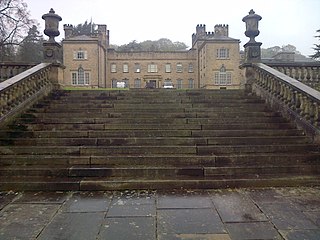
Aske Hall is a Georgian country house, with parkland attributed to Capability Brown, 1.5 miles (2.4 km) north of Richmond, North Yorkshire, England. It contains an impressive collection of 18th-century furniture, paintings and porcelain, and in its grounds a John Carr stable block converted into a chapel in Victorian times with Italianate decor, a Gothic-style folly built by Daniel Garrett circa 1745, coach house with carriage, Victorian stable block, walled garden, terraced garden and lake with a Roman-style temple. The hall and estate are currently owned by the Marquess of Zetland.
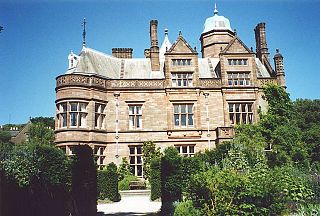
Holker Hall is a privately owned country house located about 2 km to the southwest of the village of Cartmel in the ceremonial county of Cumbria and historic county of Lancashire, England. It is "the grandest [building] of its date in Lancashire ...by the best architects then living in the county." The building dates from the 16th century, with alterations, additions, and rebuilding in the 18th and 19th centuries. The 19th century rebuilding was by George Webster in Jacobean Revival style and subsequent renovations were by E. G. Paley. Hubert Austin had a joint practice with Paley by the 1870s and they both rebuilt the west wing after it was destroyed by a major fire in 1871, only a decade after Paley's previous work on the structure. The fire also destroyed a number of notable artworks. Holker Hall is Paley and Austin's "most important country house commission." The architectural historian Nikolaus Pevsner expressed the opinion that the west wing is the "outstanding domestic work" of Paley and Austin. In 1970 the hall itself, together with its terrace wall, were designated Grade II* Listed buildings. The house stands in an estate of about 80 hectares, and is surrounded by formal gardens, parkland and woodland. Within the grounds are six structures listed at Grade II.

Lady Rose Mary Primrose McLaren was a British aristocrat, the fourth daughter of the 6th Marquess of Anglesey.

Plas Newydd is a country house set in gardens, parkland and surrounding woodland on the north bank of the Menai Strait, in Llanddaniel Fab, near Llanfairpwllgwyngyll, Anglesey, Wales. The current building has its origins in 1470, and evolved over the centuries to become one of Anglesey's principal residences. Owned successively by Griffiths, Baylys and Pagets, it became the country seat of the Marquesses of Anglesey, and the core of a large agricultural estate. The house and grounds, with views over the strait and Snowdonia, are open to the public, having been owned by the National Trust since 1976.
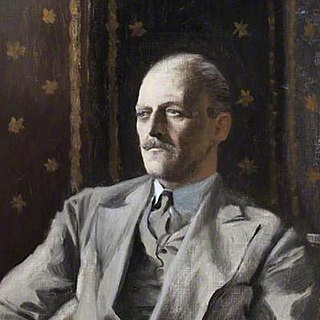
Lieutenant-Colonel Charles Henry Alexander Paget, 6th Marquess of Anglesey, was a British peer, farmer and soldier.
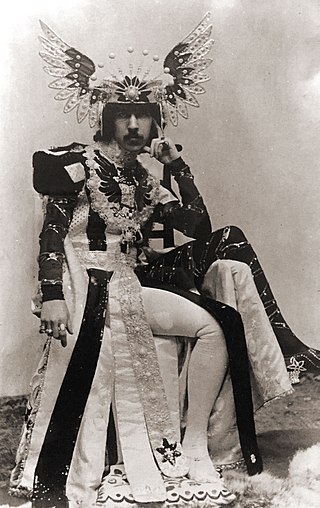
Henry Cyril Paget, 5th Marquess of Anglesey, styled Lord Paget until 1880 and Earl of Uxbridge between 1880 and 1898, and nicknamed "Toppy", was a British peer who was notable during his short life for squandering his inheritance on a lavish social life and accumulating massive debts. Regarded as the "black sheep" of the family, he was dubbed "the dancing marquess" and for his Butterfly Dancing, taken from Loie Fuller, where a voluminous robe of transparent white silk would be waved like wings.
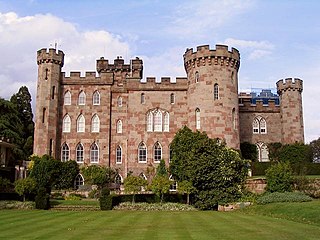
Cholmondeley Castle is a country house in the civil parish of Cholmondeley, Cheshire, England. Together with its adjacent formal gardens, it is surrounded by parkland. The site of the house has been a seat of the Cholmondeley family since the 12th century. The present house replaced a timber-framed hall nearby. It was built at the start of the 19th century for George Cholmondeley, 1st Marquess of Cholmondeley, who designed most of it himself in the form of a crenellated castle. After the death of the Marquess, the house was extended to designs by Robert Smirke to produce the building in its present form. The house is designated by English Heritage as a Grade II* listed building.

Crewe Hall is a Jacobean mansion located near Crewe Green, east of Crewe, in Cheshire, England. Described by Nikolaus Pevsner as one of the two finest Jacobean houses in Cheshire, it is listed at grade I. Built in 1615–36 for Sir Randolph Crewe, it was one of the county's largest houses in the 17th century, and was said to have "brought London into Cheshire".

Chase is a term used in the United Kingdom to define a type of land reserved for hunting use by its owner. Similarly, a Royal Chase is a type of Crown Estate by the same description, where the hunting rights are reserved for a member of the British Royal Family.
Teddesley Hall was a large Georgian English country house located close to Penkridge in Staffordshire, now demolished. It was the main seat firstly of the Littleton Baronets and then of the Barons Hatherton. The site today retains considerable traces of the hall, gardens and other buildings, while the former home farm remains a working farm.

Sir Edward Littleton of Pillaton Hall, 4th Baronet, was a long-lived Staffordshire landowner and MP from the extended Littleton/Lyttelton family, who represented Staffordshire in the Parliament of Great Britain and the Parliament of the United Kingdom for a total of 28 years. The last of the Littleton Baronets of Pillaton Hall, he transferred the family seat from eponymous Pillaton to Teddesley Hall, and died childless, leaving the estates to his great-nephew, Edward Walhouse, who became Edward Littleton, 1st Baron Hatherton.
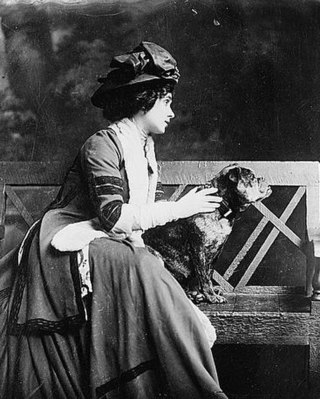
Victoria Marjorie Harriet Paget, Marchioness of Anglesey was a British writer on art, an illustrator, and a member of the peerage.
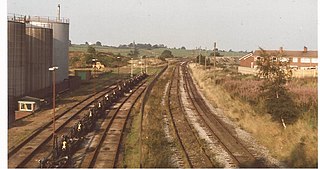
The Anglesey Sidings is a former sidings terminal located on the South Staffordshire Line, Staffordshire, England, and served for a time as an oil terminal. The sidings are located on the other end of the A5 Watling Street in Brownhills near the border of Lichfield.
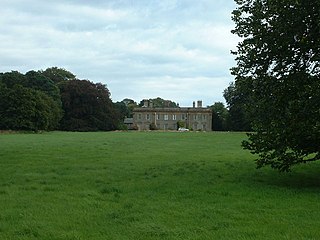
Leeswood Hall is a country house in Leeswood, Flintshire, Wales. Dating from 1742, it was built for George Wynne, the design being attributed to Francis Smith. Construction reputedly cost £40,000. The hall is a Grade II* listed building. To the northwest of the hall stand the White Gates, which have their own Grade I listing. The gates terminate the view from the hall across the lawns, an early and rare example of 18th century parkland design by Stephen Switzer, and a Grade I listed landscape of national significance.

Sinai Park House is a grade II* listed building in Burton upon Trent, Staffordshire, England. Consisting of a central range with two wings the building is sited on a ridge of high ground near a chalybeate spring. The earliest remains of the site date to the 13th-century and it was occupied by the de Scobenhal family before being donated to Burton Abbey. The house was used as a place of convalescence for monks recovering from blood-letting procedures and its original name "seyney house" derived from the Old French "seyne" for blood. The estate was increased by enclosure and used as a hunting ground for the abbot. Much of the estate and house were let out by the early 16th century. The estate came into the hands of the Paget family after the Dissolution of the Monasteries. The Pagets used it for hunting and let out part of the estate to farmers. The house adopted its modern name of Sinai by the end of the 18th-century, a biblical reference.

























